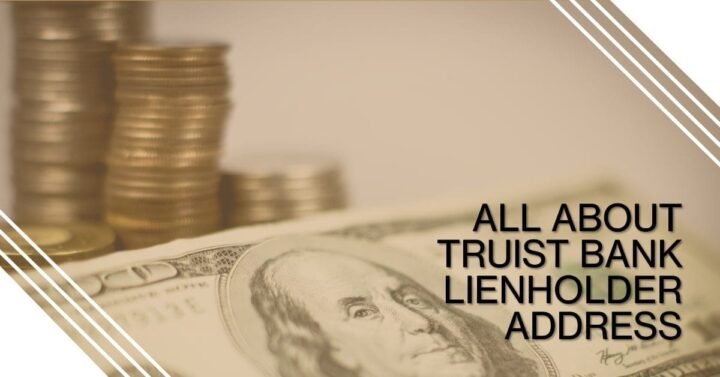Truist Bank Lienholder Address: What You Need to Know
If you have a loan or lease with Truist Bank, you may need to know their lienholder address for various purposes, such as registering your vehicle, updating your insurance policy, or sending a payoff check. A lienholder is a person or entity that has a legal right to your property until you pay off your debt. In this case, Truist Bank is the lienholder of your vehicle, and you are the borrower or lessee.
But what is the Truist Bank lienholder address, and how can you find it? In this article, we will answer these questions and provide you with some useful tips and resources to help you manage your loan or lease with Truist Bank. We will also explain what a lienholder address is, why it is important, and what to do if you need to change it. By the end of this article, you will have a better understanding of the Truist Bank lienholder address and how to use it.
What is the Truist Bank Lienholder Address?
The Truist Bank lienholder address is the physical or mailing address where you can send payments, documents, or correspondence related to your loan or lease with Truist Bank. Depending on the type and location of your vehicle, the Truist Bank lienholder address may vary. However, according to the Truist website, the most common lienholder addresses for Truist Bank are:
- For standard letters: PO Box 580223, Charlotte, NC 28258
- For overnight deliveries: Lockbox #580223, 5130 Parkway Plaza Blvd, Charlotte, NC 28217
These addresses are for auto loans and leases only. If you have a different type of loan or lease with Truist Bank, such as a mortgage, a personal loan, or a business loan, you may need to use a different lienholder address. You can find the specific lienholder address for your loan or lease by logging into your online account, calling the customer service number, or checking your loan or lease agreement.
Why is the Truist Bank Lienholder Address Important?
The Truist Bank lienholder address is important for several reasons. First, it is the address where you need to send your monthly payments, unless you choose to pay online or by phone. If you send your payments to the wrong address, you may incur late fees, penalties, or even default on your loan or lease. Therefore, you should always verify the correct lienholder address before mailing your payments.
Second, the Truist Bank lienholder address is the address where you need to send your payoff check if you want to pay off your loan or lease early. A payoff check is a check that covers the remaining balance of your loan or lease, plus any fees or interest. Paying off your loan or lease early can save you money on interest and free up your cash flow. However, you need to make sure that you send your payoff check to the right lienholder address, and that you include your account number and other relevant information. Otherwise, your payoff may be delayed or rejected.
Third, the Truist Bank lienholder address is the address that you need to provide to your insurance company, your state’s department of motor vehicles (DMV), and any other third parties that require proof of your loan or lease. For example, if you register your vehicle, you need to show your title or registration certificate, which lists Truist Bank as the lienholder. If you change your insurance policy, you need to notify your insurance company of the Truist Bank lienholder address, so that they can send them a copy of your insurance card and declaration page. If you are involved in an accident, you need to inform Truist Bank of the lienholder address, so that they can process your claim and protect their interest in your vehicle.
How to Find the Truist Bank Lienholder Address?
There are several ways to find the Truist Bank lienholder address for your loan or lease. Here are some of the most common methods:
- Check your loan or lease agreement. Your loan or lease agreement is the contract that you signed when you obtained your loan or lease from Truist Bank. It contains all the terms and conditions of your loan or lease, including the lienholder address. You should keep a copy of your loan or lease agreement in a safe place, and refer to it whenever you need to find the lienholder address.
- Log into your online account. If you have an online account with Truist Bank, you can log in and access your loan or lease information, including the lienholder address. You can also make payments, view your statements, request a payoff quote, and update your personal information online. To create or access your online account, visit the Truist website and click on “Log in”.
- Call the customer service number. If you don’t have an online account, or if you prefer to speak to a representative, you can call the customer service number for Truist Bank. The customer service number for auto loans and leases is 844-4TRUIST (844-487-8478). You can also find the customer service number for other types of loans and leases on the Truist website. When you call, you will need to provide your account number, your name, and your date of birth. The representative will then give you the lienholder address for your loan or lease.
- Visit a branch. If you live near a Truist Bank branch, you can visit in person and ask for the lienholder address for your loan or lease. You can find the nearest branch by using the branch locator tool on the Truist website1. You will need to bring your account number, your ID, and your loan or lease agreement. The branch staff will then assist you with finding the lienholder address.
How to Change the Truist Bank Lienholder Address?
In some cases, you may need to change the Truist Bank lienholder address for your loan or lease. For example, if you move to a different state, you may need to update your registration and insurance information, and notify Truist Bank of your new address. Or, if you refinance your loan or lease with another lender, you may need to remove Truist Bank as the lienholder and add the new lender instead.
To change the Truist Bank lienholder address, you will need to follow these steps:
- Contact Truist Bank and request a change of lienholder address. You can do this by calling the customer service number, logging into your online account, or visiting a branch. You will need to provide your account number, your old and new addresses, and the reason for the change. You may also need to provide proof of your new address, such as a utility bill, a lease agreement, or a bank statement.
- Contact your insurance company and update your policy. You will need to inform your insurance company of the new lienholder address, and request a new insurance card and declaration page. You will also need to make sure that your insurance coverage meets the requirements of your loan or lease agreement, and that Truist Bank is listed as the loss payee or additional insured on your policy.
- Contact your state’s DMV and update your registration. You will need to update your vehicle registration with your new address and lienholder information. You may need to pay a fee, submit a form, or provide a copy of your title or registration certificate. You will also need to get a new license plate or sticker, if applicable.
- Wait for confirmation from Truist Bank. Once you have completed the steps above, Truist Bank will process your request and send you a confirmation letter or email. You should keep this confirmation for your records, and check your statements and online account to make sure that the change has been reflected.
How do I remove Truist Bank as the lienholder?
To remove Truist Bank as the lienholder, you will need to pay off your loan or lease in full, and wait for Truist Bank to send you a lien release by mail. A lien release is a document that shows that you have paid off your loan or lease, and that Truist Bank no longer has a legal right to your vehicle. You will need a lien release to sell, trade, or donate your vehicle, or to refinance your loan or lease with another lender.
According to the Truist website, it may take up to 10 business days after your payoff date for Truist Bank to send you the lien release by mail. You can also request a lien release by calling the customer service number, logging into your online account, or visiting a branch. You will need to provide your account number, your name, and your date of birth.
Once you receive the lien release, you will need to contact your state’s department of motor vehicles (DMV) and update your title and registration. You may need to pay a fee, submit a form, or provide a copy of your title or registration certificate. You will also need to get a new license plate or sticker, if applicable.
If you have any questions or concerns, please feel free to contact Truist Bank at 844-4TRUIST (844-487-8478), or visit their website for more information.
FAQs
Here are some frequently asked questions about the Truist Bank lienholder address:
What is the difference between a lienholder address and a loss payee address?
A lienholder address is the address where you send payments, documents, or correspondence related to your loan or lease. A loss payee address is the address where your insurance company sends payments, documents, or correspondence related to a claim or a loss. In most cases, the lienholder address and the loss payee address are the same, but they may differ depending on the type and location of your vehicle.
How can I get a lien release from Truist Bank?
A lien release is a document that shows that you have paid off your loan or lease, and that Truist Bank no longer has a legal right to your vehicle. You will need a lien release to sell, trade, or donate your vehicle, or to refinance your loan or lease with another lender. To get a lien release from Truist Bank, you will need to pay off your loan or lease in full, and wait for Truist Bank to send you the lien release by mail. This may take up to 10 business days after your payoff date. You can also request a lien release by calling the customer service number, logging into your online account, or visiting a branch.
How can I get a payoff quote from Truist Bank?
A payoff quote is an estimate of how much you need to pay to pay off your loan or lease early. It includes the remaining principal, interest, fees, and any prepayment penalties. To get a payoff quote from Truist Bank, you can call the customer service number, log into your online account, or visit a branch. You will need to provide your account number, your name, and your date of birth. You will also need to specify the payoff date, which is the date when you plan to send your payoff check. The payoff quote is valid for 10 days, and may change if you make additional payments or incur fees.
Conclusion
The Truist Bank lienholder address is an important piece of information that you need to know if you have a loan or lease with Truist Bank. It is the address where you send payments, documents, or correspondence related to your loan or lease. It is also the address that you need to provide to your insurance company, your state’s DMV, and any other third parties that require proof of your loan or lease.
The Truist Bank lienholder address may vary depending on the type and location of your vehicle, but the most common lienholder addresses for auto loans and leases are:
- For standard letters: PO Box 580223, Charlotte, NC 28258
- For overnight deliveries: Lockbox #580223, 5130 Parkway Plaza Blvd, Charlotte, NC 28217
You can find the specific lienholder address for your loan or lease by checking your loan or lease agreement, logging into your online account, calling the customer service number, or visiting a branch.
You may also need to change the Truist Bank lienholder address if you move to a different state, or if you refinance your loan or lease with another lender. To do this, you will need to contact Truist Bank and request a change of lienholder address, and then update your insurance policy and your vehicle registration accordingly.
We hope that this article has helped you understand the Truist Bank lienholder address and how to use it. If you have any questions or concerns, please feel free to contact Truist Bank at 844-4TRUIST (844-487-8478), or visit their website for more information.







